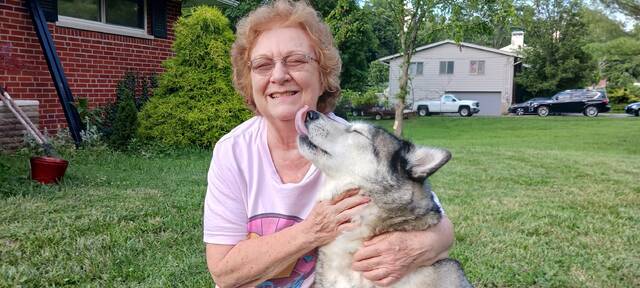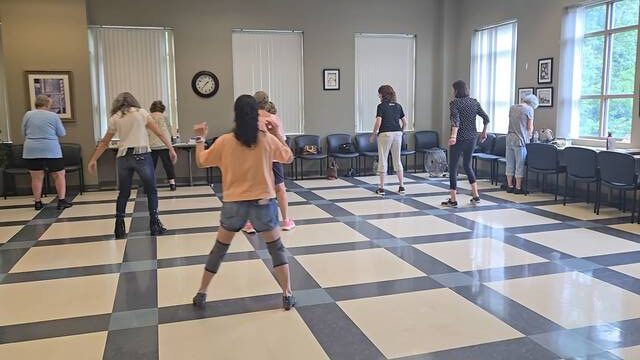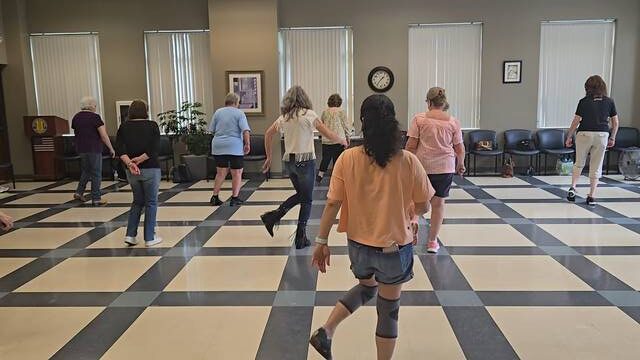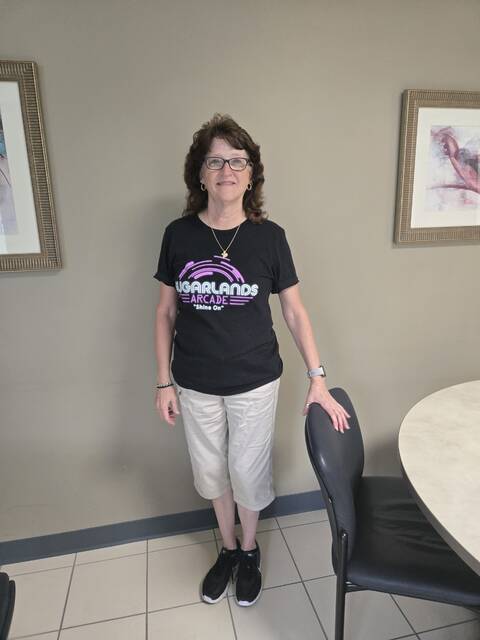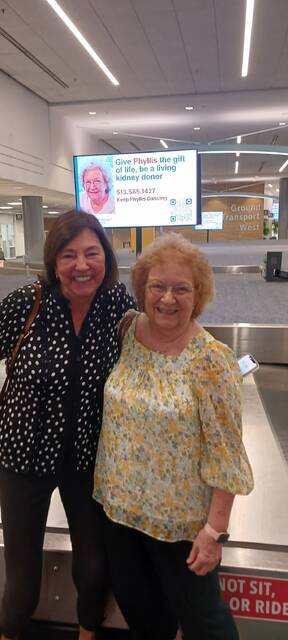Every Thursday afternoon, you will find Phyllis Gregory teaching the newest line dances to an enthusiastic and high-energy group of dancers at the Union Township Senior and Civic Center. She also teaches at Anderson Township Senior Center every Monday.
Gregory was inspired to learn line dancing when the 1980 movie “Urban Cowboy” was released. Starring then 26-year-old John Travolta, Urban Cowboy ignited a national wave of country music, mechanical bull riding and line dancing.
Gregory went to local bars to learn line dancing and ultimately found a place called Country Connection in Loveland. Her love affair with line dancing was in progress. Along the way, one of her instructors asked her and a friend, based on their dancing abilities, to substitute teach during her absence. Gregory agreed, but her friend backed out, so Gregory taught alone and soon discovered that it was just the beginning of her teaching passion.
She gets great satisfaction from hearing folks excitedly saying“ I got it” or “I did it” when learning a new dance. She tells her students it just takes time, patience, and the desire to line dance by learning patterns.
Gregory was born in Clermont County, her home being Williams Corner, near state Route 132 and state Route 131. Her mother worked in the little grocery store nearby while her dad was in the service.
Gregory presently lives in Milford and has been a lifelong Clermont County resident except for her four years as a Navy wife in Florida, Virginia and California.
Gregory has been on dialysis since November 2023. There is no history of kidney disease in her family, but there is a history of high blood pressure. She was diagnosed with high blood pressure, one of the leading causes of kidney failure in the United States, in 2008. Her kidney function has been gradually declining over the past 17 years, but it has worsened, and she is in kidney failure.
There are only two options for survival with kidney failure: dialysis or transplant. Dialysis is what keeps Gregory alive. While on dialysis, a strict diet is a must, and only 32 ounces of fluid a day are permitted. That includes all foods that have liquid in them, like soups, gravies, sauces, and fruits like watermelon. Just the thought of only four glasses of liquid a day permitted feels dehydrating, especially in the parched, oppressive summer heat.
Dialysis takes place three times a week for three hours each time. Gregory gets very cold during the procedure, even with blankets, warmers, and thermal clothing. In dialysis, blood is circulated out of the body as the dialysis machine substitutes for the kidneys. Her blood is filtered and cleansed as toxins are removed and returned to her body. The fluid that does the filtering is cooler than normal body temperature, and thus, the coldness is experienced.
The access for the circulation of her blood through the dialysis machine and back is through two cannulated needle sticks in her arm each time. Gregory applies a prescription numbing cream before each visit to help decrease the pain of the sharp needle pricks. Gregory initially had surgery by a vascular surgeon, who, through an incision in her arm, created the needle access area with her vein and artery. He explained it as “rerouting God’s plumbing” to be able to interface with the artificial kidney, the dialysis machine. This is known as a fistula and is monitored closely with each dialysis.
The last hour is misery as Gregory yearns to move about. Sitting still for three hours is definitely not in her DNA. Nevertheless, she is grateful, knowing dialysis is her lifeline. She does drive herself to and from dialysis, and to pass the time while there, she reads, does crossword puzzles, sudoku, watches TV, and chats with the person next to her.
Her nephrologist made the referral to the kidney transplant unit at Christ Hospital to place her on the transplant list to receive a kidney from a deceased donor. University Hospital is the only other hospital in the area that is equipped for kidney transplants.
It took her six months to eventually get approved to be on the waiting list. It started out with an assessment by the medical team, and once that passed, the appointments started. There is much testing to be done, including bloodwork, tissue typing, stress tests, cardiac evaluations, kidney scans, upper gastrointestinal series, colonoscopy, gynecology exams, and much more, even including a dental exam.
Once the testing was completed, the transplant coordinator set up a meeting with a transplant surgeon for even further evaluation. After the surgeon gave a stamp of approval, her case was presented to the transplant team, and upon their approval, Gregory was listed on the United Network for Organ Sharing. (Wow, that process gives a whole new meaning to jumping through hoops.)
Gregory says some days are better than others. Dialysis is hard on the body, resulting in extreme fatigue, cramping, weakness, low blood pressure, anemia, and bleeding from the needle sites. But none of that has stopped Gregory from teaching urban cowboys and cowgirls how to kick up their heels to the tunes of swing, rock, pop, soul, hip hop, and Latin musical genres, to name a few, and of course country.
Gregory is an animal lover, rescuing many animals over the years and finding homes for them. She is an avid reader and enjoys cultivating plants that benefit wildlife, including bees and butterflies.
Her professional roles started out as a receptionist, clerk, typist, tax preparer, and a Finance Office Accounting Officer for a government agency before finally retiring.
Phyllis is one of those folks who touch the lives of many. She has a quiet, gentle presence about her. Always displaying a positive outlook, she makes the most of each day. She handles tough situations with a strength guided by her faith. Her daughter says her mother is remarkable in the way she approaches daily struggles as just stepping stones to something greater. Her daughter says she can only hope to have the same mental fortitude and grace that her mom has in “tackling life‘s curve balls.” She describes her as a true friend, a patient mentor, and a dedicated mother. She said a new kidney would give her the gift of more time with her mom, with whom she is blessed.
Gregory’s students have said she has a talent for teaching. She has a way of interacting with folks that makes them feel accepted and valued. She is kind, upbeat, and fun to be with. Her students did not think she could keep dancing and teaching while on dialysis, but Gregory keeps going, living by her mantra, “live, love and line dance!”
The wait times to get a kidney from a deceased donor are an average of three to five years or longer. There are approximately 90,000 folks on the wait list.
Gregory’s doctor and transplant teams have advised her to look for a living donor. Gregory is presently working with Breanna Bronson, the living donor coordinator at Christ Hospital, and they have created a Facebook page, hoping to find a donor.
Most living donor surgeries are done laparoscopically with two or three small incisions under general anesthesia, and discharge is usually 24 to 48 hours after surgery.
Typically, the left kidney is chosen for transplant, given it’s easier to remove and transplant, because of its anatomical shape, but each case is evaluated individually.
Approximately 6,000 individuals in the United States donate a kidney every year, according to the UNOS. Generally speaking, people donate to family members or close friends, but there is a percentage who donate to someone they don’t know, and they are referred to as Good Samaritan Kidney Donors.
Basic tests needed to determine donor compatibility include blood typing, tissue typing and cross-matching. Medical exams include infectious disease screening and typical tests, including EKG, chest x-ray, CT scan or MRI of the kidneys, cardiac stress test and a dental exam. Donors also undergo psychosocial evaluation.
Donating a kidney does not change one’s life expectancy. Studies have shown that donors tend to live longer than the average person, and this is probably because donors need to be in very good health.
Most folks with one good, healthy kidney live normal, healthy lives, similar to those with two kidneys. The remaining kidney can compensate for the missing kidney.
Kidney donors often share stories of emotional fulfillment that they experienced from helping someone in need. Many donors highlight the positive impact on the recipient’s life, emphasizing being able to give them a second chance at life. Overall, the experience is often described as positive and rewarding with a strong sense of purpose and fulfillment.
The minimum age required for a living donor is 18, but there is really no maximum age. There have been folks in their 70s who have donated. It depends more on the health of the donor, rather than age.
Some interesting facts:
– The youngest person to receive a kidney transplant from a deceased donor was a 17-month-old toddler who received a kidney from a 10-day-old baby.
– The oldest person to receive a kidney transplant from a living donor was 87.
– The world’s longest surviving kidney transplant recipient, at 81 years, received her transplant at the Mayo Clinic more than 57 years ago.
– In the United States, there are 800,000 individuals living with end-stage kidney disease, and 32 percent of people with ESKD have received a kidney transplant, with 555,000 people currently on dialysis.
– Typically, the failing kidney is left in place during a transplant, with the donor kidney placed in the right or left side of the lower abdomen.
– The first successful kidney transplant done in the United States was in 1954 at Boston’s Brigham and Women’s Hospital. It was between two identical, twin brothers.
– The first successful dialysis machine was invented by Dr. William Willemkolf, a Dutch physician recognized as the father of dialysis. He began working on the concept in the late 1930s, and then during World War II, he made a dialysis machine from an old washing machine and sausage casings. He then successfully used his dialysis machine to treat a 67-year-old woman in a coma, marking the first time a patient in acute kidney failure was saved by dialysis.
Below are a few comments from some of Gregory’s line dance students:
– Denise Bein said, “I have known Phyllis for 10 years, and she brings so much joy to many people through her devotion to teaching dance. She even teaches on the day of dialysis! She is talented and prepares for each class, which is a lot of work! It was a wonderful day when Phyllis came into my life!”
-Beth Hammond said, “Phyllis is kind, generous and very patient. She wants everyone to feel welcome and included, which is a great quality, and she just makes me want to dance.”
– Kim Joens said, “I have been learning line dancing from Phyllis for 14 years, and she is a wonderful person, very friendly, and she gives me a lot of advice. I want her to stay here to teach us for another 20 years.”
Jane Wedding said, “I just liked Phyllis from the very first time I met her teaching at Lebo’s in 1997, and we became friends ever since. I think she is the best line dance teacher. She is kind, always thinking of everybody else, and she is so considerate. We both love animals so much, and she’s a very dear friend. I thank God every day that I am her friend.”
– Amy Evans said, “Phyllis sends out the best jokes!”
– Joyce Strain said, “I like Phyllis as our teacher because she is really very passionate about line dancing and teaching. When we are new or learning a new dance, we can ask her to repeat it over again and again, and she never tires of teaching us. She always has a new dance for us to learn and if some steps are difficult for us, she will break them down and make sure we learn.”
The phrase “Have Kidney – Will Travel ” is a play on words lifted from the old western TV series, “Have Gun – Will Travel.”
It takes an extraordinary amount of planning and coordination with medical facilities for someone on dialysis to travel. “As one person, I cannot change the world, but I can change the world of one person.” – Paul Shane Spear
For personal heartfelt stories from kidney donors and more information on the kidney donor process, search the following sources included in article:
– National Kidney Foundation
– National Kidney Registry
– National Kidney Donation Project
– Donate Life America
For interest and information in helping Phyllis Gregory, please contact Living Donor Coordinator Breanna Bronson at The Christ Hospital at 513-585-1427 or [email protected]. The living donor process is confidential, and Phyllis will not be notified if you contact the transplant team. Also, all costs for testing and surgery are covered by Gregory’s insurance. For more information, visit Keep Phyllis Dancing on Facebook.
Subscribe to The Clermont Sun today!
https://www.clermontsun.com/subscribe

